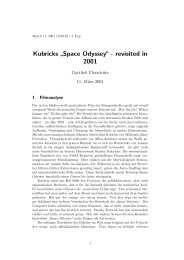Henry M. Taylor, 'Frames, Cons, and Double-Crosses - Cinetext
Henry M. Taylor, 'Frames, Cons, and Double-Crosses - Cinetext
Henry M. Taylor, 'Frames, Cons, and Double-Crosses - Cinetext
Create successful ePaper yourself
Turn your PDF publications into a flip-book with our unique Google optimized e-Paper software.
interest <strong>and</strong> meaning of which is not their concern, as it has already been established as such (or<br />
not) by the author. Thus, the actor who feels stage fright, is afraid of not being fully prepared for<br />
her or his role, must learn to be more aggressive, to physically act <strong>and</strong>, above all, be brave: ―The<br />
skill of acting is like the skill of sport, which is a physical event. [...] Like sports, the study of act-<br />
ing consists in the main of getting out of one's way, <strong>and</strong> in learning to deal with uncertainty <strong>and</strong><br />
being comfortable being uncomfortable. [...] The truth of the moment is another name for what is<br />
actually happening between two people onstage. That interchange is always unplanned, is always<br />
taking place, is always fascinating [...]. When the actual courage of the actor is coupled with the<br />
lines of the playwright, the illusion of character is created.‖ 16 The falsity of Stanislavskian me-<br />
thod acting, according to this approach, consists in trying to consciously predetermine the mean-<br />
ing of the actor's confrontation with the lines of the play <strong>and</strong> with the other actors on stage, whe-<br />
reas an outward, externalized attitude towards ―character‖ will activate the unconscious, allowing<br />
it to speak out in a moment of truth – a truth effectively none other but performance as such. To<br />
this end, the actor must not believe himself to be the scripted personage, as method acting would<br />
have it, but merely to pretend, to imagine being that ―character,‖ <strong>and</strong> act out the only thing that is<br />
real, namely, clearly speaking the lines of the script <strong>and</strong> performing simple physical actions in<br />
pursuit of a straightforward objective, the objective being what the imaginary character wants.<br />
Hence an effective play should be like a well-told joke: ―In a well-written play, <strong>and</strong> in a correctly<br />
performed play, everything tends also toward a punchline. That punchline, for the actor, is the<br />
objective, which means 'What do I want?' [...] To free ourselves from having to decide whether<br />
something is effective, beautiful, or germane, we ask the question 'Is it essential to the action?'<br />
<strong>and</strong> all else follows. [...] If we devote ourselves to the punchline, all else becomes clear. The pun-<br />
chline is the action.‖ 17<br />
A juxtaposition of uninflected images: antagonistic functionalism in film<br />
The meaning of character is action, <strong>and</strong> the action is determined by the objective of what the pro-<br />
tagonist wants; the overriding objective of the entire play or film is called by Mamet the superob-<br />
jective or throughline. The play, however, is broken down, taylorized into the actual unit of work<br />
for the director, the scene, governed by an auxiliary or scene objective, one building block among<br />
6



